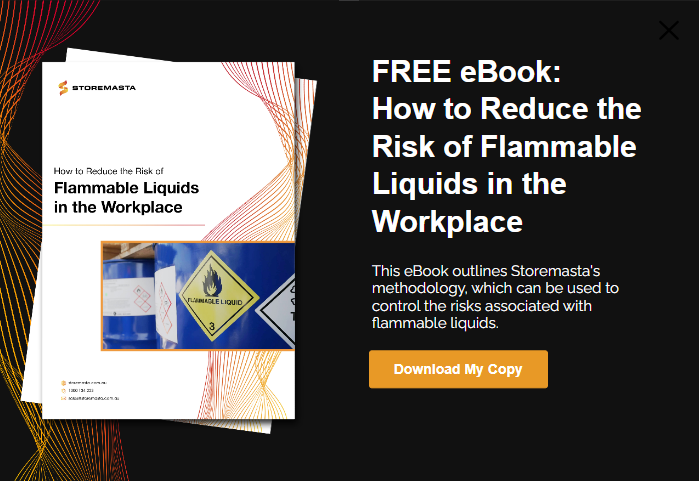As a chemical that’s used on mass across a vast range of industries, kerosene is considered a highly useful substance. Whether it’s being utilised as a solvent and lubricant in manufacturing plants or required as a jet fuel in the aviation industry, there are countless uses for this type of chemical. This blog addresses the often-asked question, ‘Is kerosene flammable’ and details how this substance should be stored in indoor and outdoor locations to maintain safety and compliance.
Let’s first explain what kerosene is and how it’s chemical properties can affect how it’s handled and stored in your workplace.
What Exactly Is Kerosene?
Kerosene is a hydrocarbon liquid that’s obtained from the fractional distillation of petroleum. Discovered in the late 1840s by Canadian physician Abraham Gasner, kerosene has been used across a broad range of industries.
The hydrocarbons that make up kerosene are relatively small — with approximately 10 to 16 carbon atoms per molecule. This chemical composition makes kerosene an ideal fuel, whether it’s for powering jets or running kerosene lamps. This chemical is typically pale yellow or colourless and has an unpleasant ‘oily’ odour.
Is Kerosene Classed As Flammable?
The Australian Dangerous Goods (ADG) Code classifies Class 3 Flammable Liquids as liquids or mixtures of liquids, such as kerosene, that have a flash point below 60 °C.
IMPORTANT: A flashpoint is the temperature at which substances give off enough flammable vapours to ignite in the presence of an ignition source.
Kerosene has a flash point range between 37 and 65 °C. When comparing kerosene to a flammable liquid such as petrol (which has a low flash point of -43 degrees °C), it’s regarded as a less flammable and volatile substance due to its flash point range. To determine the flammability of your onsite flammable liquids, you’ll need to refer to the individual Safety Data Sheet (SDS) of each flammable chemical that you carry.
An example of an SDS for Caltex Kerosene appears below:

How Flammable Is Kerosene?
If your business uses kerosene on a regular basis, it’s very important that you’re aware of its dangerous properties. Being aware of the chemical properties of kerosene will allow you to put measures in place to control chemical risks.
One dangerous property associated with kerosene is the chemical’s flammability. Like all flammable liquids, it’s not actually the liquid part of kerosene that burns, but the flammable vapours that disperse from the substance. Therefore, the more flammable vapours that a substance will produce, the more flammable it will be.

If a substance emits a large volume of flammable vapours, there is the increased risk of fire and explosion.
The main factor that determines the ability of a substance to give off flammable vapours is the strength of the forces of attraction between the molecules that make up the substance. The smaller the molecules, the weaker the intermolecular forces of attraction that will exist between the molecules. As the molecules that make up kerosene are quite small, less heat energy is required to break the intermolecular forces between the molecules and therefore they can easily escape as a gas.
At temperatures above 36 °C, kerosene will produce enough flammable vapours to form a mixture with air that will ignite in the presence of an ignition source.
Since temperatures of 36 °C are not uncommon in Australia, kerosene can be considered as a relatively flammable substance. However, when compared with other substances such as petrol, kerosene is less volatile. Petrol is so volatile that it will give off enough flammable vapours at -43 °C to ignite in the presence of an ignition source. Therefore, kerosene is very flammable, but it is less volatile and safer to use than petrol.
How To Store Kerosene
Know that we’ve established the flammability of kerosene, it’s time to discuss how and where you should store kerosene in your workplace.
As we’ve previously mentioned, kerosene is classified as a Class 3 Flammable Liquid. Therefore, it must be stored in full conformance to the requirements outlined in the Australian Standard AS 1940:2017 - The storage and handling of flammable and combustible liquids.
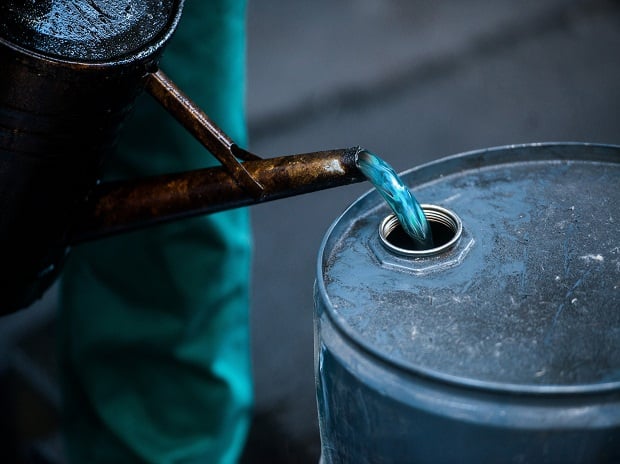
Kerosene, like all Class 3 Flammable Liquids, should be stored in conformance with AS 1940:2017.
While the Australian Standards are not law, certain sections of the Standards may be referenced in a dangerous goods regulation. When this occurs, organisations and their responsible personnel can be prosecuted for not adhering to the section of the Standard that was referenced in the Dangerous Goods Regulation.
The Australian Standards are often mentioned in the Dangerous Goods Regulations and are accepted as an important solution for meeting regulatory compliance.
AS 1940:2017 outlines different requirements for the indoor storage of flammable liquids and the outdoor storage of flammable liquids. We’ll explain the requirements in further detail below:
Storing Kerosene Indoors
As a flammable liquid, kerosene may be safely stored indoors using a flammable liquids storage cabinet.
Section 4.9 of AS 1940:2017 outlines the requirements for indoor flammable liquids storage cabinets. This section outlines the requirements regarding the cabinet’s:
- Construction
- Marking
- Ventilation
- Location
- Exclusion from ignition sources
- Operation requirements
If a cabinet doesn’t meet the stringent requirements of the Standard, the cabinet can’t be used for the storage of kerosene.
Some of the construction requirements for flammable liquids storage cabinets include:
- A double-walled sheet steel construction with a 40mm air gap
- Self-closing closing fitting doors that hold shut by catches at two or more points
- A 150mm deep spill containment sump in the bottom of the cabinet
- Perforated shelves that allow free air movement within the cabinet
Indoor flammable storage cabinets must also have the correct dangerous goods signage to warn workers of any hazards associated with the dangerous substances stored within the cabinet.
 Only flammable cabinets that have been constructed to conform with Australian Standard 1940:2017 are considered suitable for the indoor storage of kerosene.
Only flammable cabinets that have been constructed to conform with Australian Standard 1940:2017 are considered suitable for the indoor storage of kerosene.
The cabinet must also have the provision for a ventilation system. The installation of a mechanical ventilation system may be required in to keep the concentration of the flammable vapours inside the cabinet below the workplace exposure standards.
IMPORTANT: As with all flammable liquids, care must be taken to ensure that the flammable liquids storage cabinet and any flammable liquid outdoor stores are isolated from possible workplace ignition sources by a distance of at least 3 metres.
Storing Kerosene Outdoors
If you have larger quantities of kerosene, it’s safer to store them in an outdoor location.
AS 1940:2017 states that indoor flammable liquids storage cabinets must not have a capacity that exceeds 850L. Therefore, larger quantities of flammable liquids must be kept outdoors in order to reduce risk.
The most practical method for storing flammable liquids in the outdoor environment is to use a chemical storage container that has been manufactured in full conformance to AS 1940:2017.
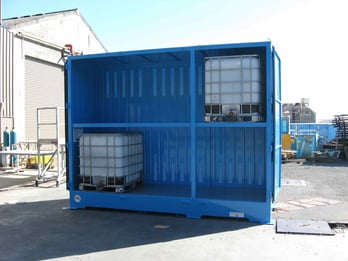 When storing larger quantities of kerosene, choose an outdoor storage container that’s in full conformance with Australian Standards.
When storing larger quantities of kerosene, choose an outdoor storage container that’s in full conformance with Australian Standards.
Section 4.1 - 4.8 of AS 1940 outlines the requirements for the design and construction of flammable chemical storage containers.
The requirements outlined in these sections include:
- Ventilation
- Spillage containment
- Markings and signage
- Segregation from incompatible chemicals
For a chemical storage container to be compliant, it must have at least two walls of fixed louvers with at least 50% of the walls being openings. This ventilation ensures that the concentration of the flammable vapours within the store are kept at a safe concentration.
To minimise the risk of fire, explosion and human harm — as well as protect the environment from any spills that may occur — all chemical storage containers must have a spill containment sump.
According to the Standard, a compliant spill containment sump must have the capacity to hold 100% of the capacity of the largest container within the store as well as 25% of the aggregate capacity of container. For chemical storage containers that have the capacity of greater than 10,000L, the spill containment sump must have an extra capacity of a least 10% of every litre stored between 10,000L and 100,000L. For flammable liquids stores with a capacity greater than 100,000L, their spill containment sumps must have an extra capacity of at 5% of every litre exceeding 100,000L.
Flammable liquids, such as kerosene, must also be safely segregated from other incompatible classes of Dangerous Goods. If incompatible substances mix, they will cause violent chemical reactions. Therefore, flammable liquids must be safely segregated from other incompatible substances by following the requirements outlined in the dangerous goods segregation chart.
Flammable liquids storage containers must also have the correct dangerous goods signage to warn workers of the potential hazards associated with the flammable liquids being stored within the store. This includes a Class 3 Flammable Liquids diamond and a No Smoking No Ignition Sources Within 3 Metres sign.
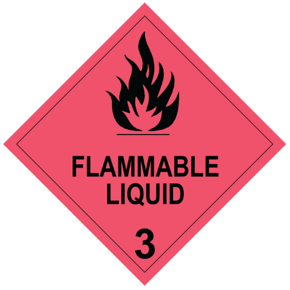
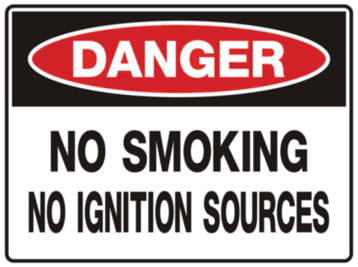 To maintain a compliant flammable store, you must display the Flammable Liquids 3 diamond as well as the No Smoking No Ignition Sources signage.
To maintain a compliant flammable store, you must display the Flammable Liquids 3 diamond as well as the No Smoking No Ignition Sources signage.
How Are You Storing Your Kerosene?
As a commonly used Class 3 Flammable Liquid that’s utilised by many industries worldwide, kerosene must be stored in a manner that’s efficient, safe and compliant. To achieve compliant indoor or outdoor storage, kerosene stores must be in full compliance with the Australian Standard AS 1940:2017.
We highly recommend that you conduct dangerous goods risk assessment to identify all the areas where kerosene is stored. This will allow you to accurately assess the severity and the likelihood of an incident occurring from the storage of the substance. Once you have identified the major risk areas, you can then start to implement some controls to reduce these serious risks. To learn more about risk reduction in your chemical stores, grab your copy of our eBook, How To Reduce The Risk Of Flammable Liquids In The Workplace. Our guide will take you step-by-step through the risk management process so you can minimise the risk of fire, explosion and human harm that kerosene stores pose to your business. Get your copy for free now.
Joining the team as a Dangerous Goods Storage Consultant, Melissa Hampton became Storemasta's Marketing Manager in late 2021. With extensive knowledge and experience in chemical compliance, Melissa is responsible for leading the Marketing team and helping shape their marketing strategy. In her spare time, you can find Melissa hiking, swimming and enjoying the great outdoors in beautiful north-west Tasmania.

